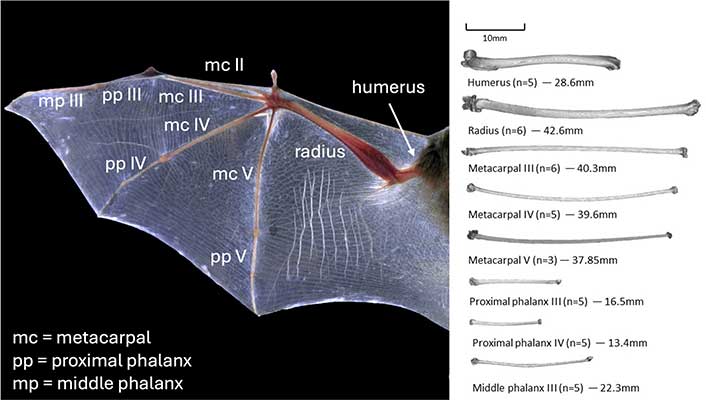Seba’s Short-Tailed Bat Displays Distinctive Wing-Bone Morphological and Material Properties

Bioengineering alumni Xiaoxiang Ma, MS’23, and MIE/BioE Professor Sandra Shefelbine, published their research on “A proximodistal gradient in bone structure and mechanics in the wings of Seba’s short-tailed bat, Carollia perspicillata” in The Anatomical Record.
Xiaoxiang (Albert) Ma began his academic journey in Mechanical Engineering in Shanghai, where his early exposure to design and systems thinking laid the foundation for his later work in medical technologies. After two years of industry experience at TÜV Rheinland, he pursued an M.S. in Bioengineering at Northeastern University. During his graduate studies, Ma explored a range of interdisciplinary courses in both mechanical engineering and biomechanics. One course in particular—Musculoskeletal Biomechanics, taught by Professor Sandra Shefelbine—sparked his interest in research and ultimately led him to join her lab as a Research Assistant.
Ma’s research in the Shefelbine Lab focused on the bone properties of the bat wing. This study investigated the structural, mechanical, and compositional properties of the wing bones of Carollia perspicillata, the Seba’s short-tailed bat. In collaboration with project members, Ma led advanced imaging studies employing micro-CT, quantitative backscattered scanning electron microscopy (SEM), and nanoindentation to analyze the bones. This work identified a clear “proximodistal gradient”—a systematic transition in which the bones change from being thick and stiff near the body to thin and flexible at the wingtip. This specialized design is critical for flight, reducing energetic cost while increasing flexibility, and serves as a blueprint for bio-inspired design in aerospace engineering, advanced materials, and robotics.
To complement his academic research with direct industry experience, Ma also completed a co-op at Takeda Pharmaceuticals during his time at Northeastern. There, he contributed to the Verification and Validation (V&V) of a novel, needle-free autoinjector system designed for high-viscosity drug delivery. Ma now serves as a Research and Development and Quality Specialist at Genadyne Biotechnologies. He contributes to the design and development of next-generation wound-care technologies; his key responsibilities include defining design inputs, supporting risk analysis, and executing V&V activities to ensure product safety and effectiveness. Ma also supports regulatory compliance by maintaining essential technical documentation—such as the Design History File (DHF) and Device Master Record (DMR)—and coordinating biocompatibility evaluations and performance testing in alignment with FDA and international standards. Committed to integrating engineering precision with clinical needs, Ma works to bring innovative solutions that enhance patient care.
Related Article: This robot flies like a bat to navigate tight spaces. Its creator says it could revolutionize how we explore the world.